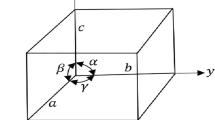Abstract
Structural changes across multiple length scales associated with hydrothermal pretreatments of biomass were investigated by using small- and wide-angle X-ray and neutron scattering on oriented specimens. Isotropic and anisotropic scattering components were numerically separated and then interpreted as contributions from matrix and cellulose components, respectively. Equatorial diffraction peaks present in the isotropic component became sharper after hydrothermal treatments or ammonia treatment. Before pretreatment the wet cell wall was found to be homogeneous in the 10–100 nm range and scattering below Q = 0.5 (nm−1) was dominated by surface scattering from the lumen. After pretreatment with acid or steam at 160 or 180 °C, density fluctuation developed in the cell wall at length scales above 10 nm, most likely due to lateral coalescence of microfibrils that partially co-crystallize to give larger apparent crystal sizes. A density fluctuation up to about 100 nm appeared in the isotropic component after acid and steam pretreatments due to morphological changes in the hemicellulose and lignin matrix.









Similar content being viewed by others
References
Chundawat SPS, Donohoe B, Sousa L, Elder T, Agarwal U, Lu F, Ralph J, Himmel M, Balan V, Dale B (2011a) Multi-scale visualization and characterization of lignocellulosic plant cell wall deconstruction during thermochemical pretreatment. Energy Environ Sci 4:973–984
Chundawat SPS, Bellesia G, Uppugundla N, da Costa Sousa L, Gao D, Cheh AM, Agarwal UP, Bianchetti CM, Phillips GN Jr, Langan P, Balan V, Gnanakaran S, Dale BE (2011b) Restructuring the crystalline cellulose hydrogen bond network enhances its depolymerization rate. J Am Chem Soc 133:11163–11174
Davidson TC, Newman RH, Ryan MJ (2004) Variations in the fibre repeat between samples of cellulose I from different sources. Carbohydr Res 339:2889–2893
Ding SY, Liu YS, Zeng Y, Himmel ME, Baker JO, Bayer EA (2012) How does plant cell wall nanoscale architecture correlate with enzymatic digestability? Science 338:1055–1060
Driemeier C, Pimenta MTB, Rocha GJM et al (2011) Evolution of cellulose crystals during prehydrolysis and soda delignification of sugarcane lignocellulose. Cellulose 18:1509–1519
Fernandes AN, Thomas LH, Altaner CM, Callow P, Forsyth VT, Apperley DC, Kennedy CJ, Jarvis MC (2011) Nanostructure of cellulose microfibrils in spruce wood. Proc Nat Ac Sci 108:E1195–E1203
French AD (2013) Idealized powder diffraction patterns for cellulose polymorphs. Cellulose. doi:10.1007/s10570-013-0030-4
Inagaki T, Siesler HW, Mitsui K, Tsuchikawa S (2010) Difference of the crystal structure of cellulose in wood after hydrothermal and aging degradation: a NIR spectroscopy and XRD study. Biomacromolecules 11:2300–2305
Ioelovitch M (1992) Zur übermolekularen Struktur von nativen und isolierten Cellulosen. Acta Polym 43:110–113
Langan P, Evans BR, Foston M, Heller WT, O’Neill H, Petridis L, Pingali SV, Ragauskas RJ, Smith JC, Urban VS, Davidson BH (2012) Neutron technologies for bioenergy research. Ind Biotechnol 8:209–216
Leppänen K, Andersson S, Torkkeli M et al (2009) Structure of cellulose and microcrystalline cellulose from various wood species, cotton and flax studied by X-ray scattering. Cellulose 16:999–1015
Littrell KC, Heller WT, Melnichenko YB, Bailey KM, Lynn GW, Myles DA, Urban VS, Buchanan MV, Selby DL, Butler PD (2012) The 40 m general purpose small-angle neutron scattering instrument at Oak Ridge National Laboratory. J Appl Crystallogr 45:990–998
Nishiyama Y, de Souza Lima MM (2013) X-ray scattering and diffraction of biopolymers. In: Thomas S, Durand D, Chassenieux C, Jyotishkumar P (Eds) Handbook of biopolymer-based materials. Willey, New York, pp. 567–581
Nishiyama Y, Langan P, Chanzy H (2002) Crystal structure and hydrogen-bonding system in cellulose Iβ from synchrotron X-ray and neutron fiber diffraction. J Am Chem Soc 124:9074–9082
Nishiyama Y, Kim UJ, Kim DY, Katumata KS, May RP, Langan P (2003) Periodic disorder along ramie cellulose microfibrils. Biomacromolecules 4:1013–1017
Pingali SV, Urban VS, Heller WT et al (2010) Breakdown of cell wall nanostructure in dilute acid pretreated biomass. Biomacromolecules 11:2329–2335
Porod G (1951) Die Röntgenkleinwinkelstreuung von dichtgepackten kolloiden Systemen. Kolloid Z 124:83–114
Wada M, Chanzy H, Nishiyama Y, Langan P (2004) Cellulose IIII crystal structure and hydrogen bonding by synchrotron X-ray and neutron fiber diffraction. Macromolecules 23:8548–8555
Acknowledgments
This research is funded by the Genomic Science Program, Office of Biological and Environmental Research, U. S. Department of Energy, under FWP ERKP752. The Center for Structural Molecular Biology (CSMB) and the BioSANS beam line are supported by the Office of Biological and Environmental Research, using facilities supported by the U. S. Department of Energy, managed by UT-Battelle, LLC under contract No. DE-AC05-00OR22725.
Author information
Authors and Affiliations
Corresponding author
Appendix
Appendix
A rough estimation of the specific surface area S (area/volume) from the SANS data at low Q end will be shown. The application of Porod’s law of X-ray scattering by the internal surface at high Q (Porod 1951; Nishiyama and de Souza Lima 2013) to neutron gives
where I is the scattered intensity in absolute scale (cm−1) and Δρ the scattering length density contrast of the surface. From the data, the experimental prefactor A = 2π(Δρ)2S was 2.5, 5.0, 1.5, 1.5 (×1024 cm5) for native, acid, steam and AFEX treated samples respectively. Since the azimuthal spread was typically 20°, these values are equivalent to their one-third in a random orientation case. If we use a (Δρ)2 between cell wall and lumen filled with heavy water as 2 × 1020 (cm−4), the specific surface
The value S varies between 3 and 10 (×103cm−1).
If we consider a typical wood fiber with square section 10 μm wide and a lumen of 6 μm wide, the specific surface will be
Thus the lumen surface area and the surface area calculated from neutron scattering prefactor agree in magnitude.
Rights and permissions
About this article
Cite this article
Nishiyama, Y., Langan, P., O’Neill, H. et al. Structural coarsening of aspen wood by hydrothermal pretreatment monitored by small- and wide-angle scattering of X-rays and neutrons on oriented specimens. Cellulose 21, 1015–1024 (2014). https://doi.org/10.1007/s10570-013-0069-2
Received:
Accepted:
Published:
Issue Date:
DOI: https://doi.org/10.1007/s10570-013-0069-2




